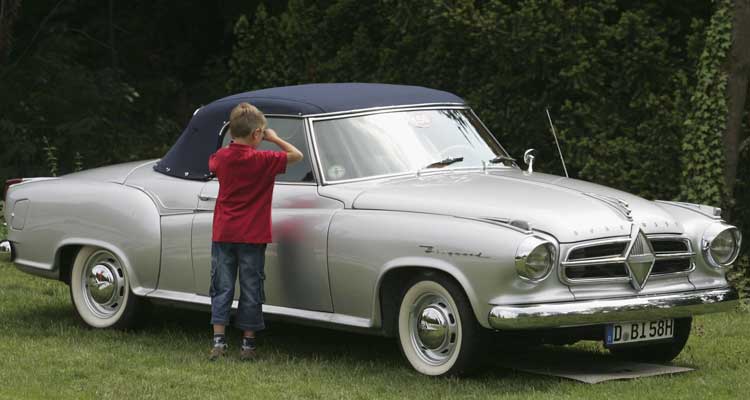Borgward Isabella Coupe
With her elegant bodywork, balanced lines and top-notch engine, Brian Sewell reflects on a coupé which still has its looks, 40 years on

One of the many compensations for the young National Serviceman stationed in West Germany in the late Fifties, was the Borgward Isabella. The unambitious boy might buy himself an early Volkswagen, with its wretched visibility, unpredictable handling, primitive finish and rackety air-cooled engine, but the lad who'd got himself the stripes of corporal, or the single pip of the lowest form of subaltern (of life indeed, as his RSM might put it in the privacy of the Sergeants' Mess), would take the more expensive and enlightened option of the Isabella, and in so doing put himself at the wheel of the world's most advanced mass production car.
That is a hefty claim to make for a conventional family saloon with its engine at the front, driving the rear wheels, and accommodating a family of five, but to any young subaltern who had been driven to his prep school in his father's Rover 12, or set off for the family holiday in Devon (then a 10-hour journey from London in a Wolseley), the Isabella was a revelation. Consider the engine in the immediate context of the day: it was a four-cylinder of only 1,493cc, yet it produced 75bhp against the 55, 57 and 63bhp of the equivalent new Austin, Hillman and MG; it spun freely to 6,000rpm, and could hold to these high revolutions for mile after mile, giving the Isabella the verve and sustained high speed of a sports car, yet retaining the forgiving flexibility that allowed tootling around in top gear at 15mph; cruising at 80mph this engine returned 25mpg, and it performed the normal give-and-take of motoring at more than 30mpg.
To Carl Freidrich-Wilhelm Borgward, a vigorous entrepreneur in his late sixties, the logical development of his remarkable saloon, far more sprightly than the lumbering 180 that was Mercedes' nearest match, was a sports coupé, and in 1957 he introduced it - close-coupled, with two luxurious front seats, a bench for bent-necked occasional passengers in the rear, and an immense boot.
As much as possible of the base saloon was used in its construction, but, as is the way of these things, the coupé was not only 40 per cent more expensive, but considerably heavier - the saloon weighed exactly a ton ready for the road, and the coupé 200lbs more. This weight told against it a little in low-speed acceleration, but if it was slightly galling to see the heels of the cheaper car at the traffic lights, the coupé, with its lower profile, had the higher maximum, with 100mph just within its grasp.
Its purpose in practice was less that of the out-and-out sports car than the grand tourer on a modest scale, endowed with comfort, refinement, luggage capacity and the performance to cross Europe at as high a speed as the roads would allow. That charming Thirties phrase, used of the Continental Rolls or Siddeley that was held back, never by the wheezing of the engine under stress, but by ruts and potholes that might shatter any car's suspension. Nothing that the still war-torn roads of Europe presented to the Isabella could throw it off-course.
It had independent suspension front and rear - coil springs, front wishbones and a rear swing-axle that enabled it to ride fact over Belgian pave, the hammering irregularities of which were then the ultimate test of any car's integrity. For a mass-produced chassis, remarkably little road roar and thump penetrated the cabin. As for handling, at high speed on autobahns it was neutral and utterly safe, but on B-roads the Isabella could be skittish, inclined to slide in the rain and oversteer on bends - another reason to regard it as a grand tourer rather than a sports car.
Forty years on, the coupé is still remarkably elegant, its balanced lines touched with something of the daring of the specialist coachbuilder, and one wonders at the prescience of a man who so long ago built the design that is the smart body of today, as well as so outstanding an engine. Borgward, born in 1890, had been in the car industry most of his life, but had begun as a manufacturer of car radiators rather than of cars. His first vehicle was a three-wheeled delivery contraption, which in 1926 he turned into a car called, impertinently, the Goliath.
In 1929 the bankrupt car firms Lloyd and Hansa fell into his hands, a bewildering profusion of ingenious cars the consequence, until in 1938 Borgward rationalised the range and for the first time used his own name on a bonnet. Post-war production at the Bremen factory began in 1948. Proliferation was again bewildering, with a Spartan fabric-bodied baby dubbed the Sticking-Plaster car at the bottom of the range, an ugly pseudo-American Mercedes-matcher of 2.3 litres at the top, and a dozen others in between.
This overlapping and confusion brought about Borgward's Götterdämmerung; in 1961 the group went into liquidation, and in 1963 Carl Friedrich-Wilhelm died. Many of his cars were laughable, absurd and grotesque, but the Isabella was a great and worthy vehicle; between 1954 and 1961 there were four variations - the Combi, a practical station wagon, and the saloon, both mass-produced; the closed coupé, a rarity, and the drop-head coupé, very rare (and even prettier). Talk of these cars to any man who owned one, and he will respond as though remembering a love affair.
Join our commenting forum
Join thought-provoking conversations, follow other Independent readers and see their replies
Comments
Bookmark popover
Removed from bookmarks